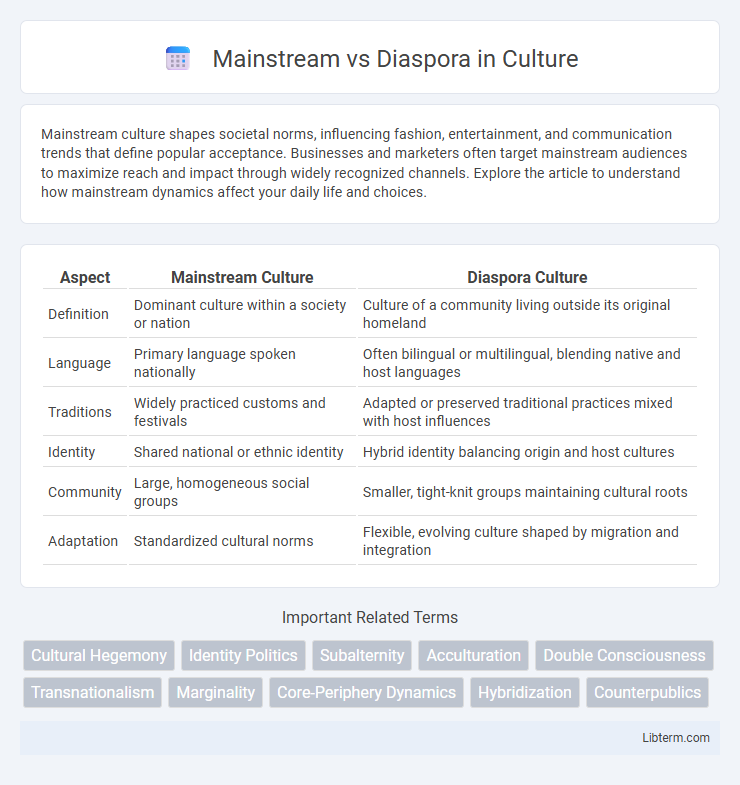Mainstream culture shapes societal norms, influencing fashion, entertainment, and communication trends that define popular acceptance. Businesses and marketers often target mainstream audiences to maximize reach and impact through widely recognized channels. Explore the article to understand how mainstream dynamics affect your daily life and choices.
Table of Comparison
| Aspect | Mainstream Culture | Diaspora Culture |
|---|---|---|
| Definition | Dominant culture within a society or nation | Culture of a community living outside its original homeland |
| Language | Primary language spoken nationally | Often bilingual or multilingual, blending native and host languages |
| Traditions | Widely practiced customs and festivals | Adapted or preserved traditional practices mixed with host influences |
| Identity | Shared national or ethnic identity | Hybrid identity balancing origin and host cultures |
| Community | Large, homogeneous social groups | Smaller, tight-knit groups maintaining cultural roots |
| Adaptation | Standardized cultural norms | Flexible, evolving culture shaped by migration and integration |
Understanding Mainstream and Diaspora: Key Definitions
Mainstream refers to the dominant cultural, social, or political norms and practices prevalent within a society, shaping collective identity and behavior. Diaspora denotes the dispersion of a population from their original homeland, maintaining connections through shared heritage, traditions, and transnational networks. Understanding these key definitions helps clarify the dynamic interactions between dominant groups and dispersed communities in multicultural contexts.
Historical Context: Origins of Mainstream and Diaspora Cultures
Mainstream cultures typically originate from dominant societies with established political, economic, and social institutions shaping their identity over centuries, such as European civilizations influencing Western norms. Diaspora cultures emerge from migration, displacement, or exile, preserving ancestral traditions while adapting to new environments, as seen in Jewish, African, and Indian diasporas worldwide. Historical contexts of colonization, trade routes, and forced migrations significantly impact the development and divergence of mainstream and diaspora cultural identities.
Cultural Identity: Shaping Perspectives and Belonging
Mainstream culture often influences individuals by promoting dominant values and social norms, shaping collective identity through shared experiences and media representation. Diaspora communities maintain distinct cultural identities by preserving language, traditions, and rituals, fostering a sense of belonging and resilience across generations. The interplay between mainstream and diaspora identities creates dynamic perspectives, enriching multicultural societies and challenging singular notions of cultural belonging.
Communication Styles: Mainstream vs Diaspora Dynamics
Mainstream communication styles often emphasize directness, linear narratives, and standardized language patterns shaped by dominant cultural norms. Diaspora communication dynamics typically incorporate multilingual expressions, non-linear storytelling, and culturally rich contexts that reflect hybrid identities and community histories. These contrasting styles influence how messages are encoded, decoded, and culturally interpreted across diverse audiences.
Representation in Media: Visibility and Stereotypes
Mainstream media often portrays diaspora communities with limited visibility, relying on stereotypes that reinforce narrow cultural identities and overlook diversity within these groups. Diaspora-focused media platforms increase authentic representation by highlighting varied narratives and challenging monolithic portrayals, promoting a richer understanding of cultural complexity. Expanding inclusive storytelling in both mainstream and diaspora media enhances visibility, reduces biases, and fosters greater social acceptance.
Social Integration: Challenges and Opportunities
Mainstream social integration often faces challenges such as cultural assimilation pressures and identity conflicts, while diaspora communities encounter barriers related to language, discrimination, and limited access to social services. Opportunities arise through intercultural dialogue, community support networks, and inclusive policies promoting multicultural participation. Effective integration fosters social cohesion, economic contribution, and mutual understanding between mainstream populations and diaspora groups.
Economic Influence: Contributions and Disparities
The economic influence of mainstream communities often reflects established industries and institutional investments, driving large-scale employment and generating significant GDP contributions. In contrast, diaspora populations frequently contribute through entrepreneurial ventures, remittances, and unique market niches, creating substantial economic linkages across borders. Despite their impactful roles, disparities arise due to limited access to capital, systemic barriers, and uneven integration into mainstream economic frameworks.
Language, Traditions, and Heritage Preservation
Language plays a pivotal role in distinguishing mainstream communities from diaspora groups, with diasporas often maintaining heritage languages to preserve cultural identity despite dominant societal tongues. Traditions in diaspora communities serve as vital links to ancestral roots, adaptively blending original customs with local influences to sustain cultural continuity. Heritage preservation within diaspora populations frequently involves organized efforts such as cultural festivals, language schools, and religious practices, ensuring the transmission of collective memory across generations amid external cultural pressures.
Navigating Dual Identities and Hybrid Experiences
Navigating dual identities within mainstream and diaspora contexts often involves balancing cultural heritage with the influences of the dominant society, creating hybrid experiences that redefine personal and collective identity. This process fosters a unique sense of belonging that incorporates both ancestral traditions and contemporary social dynamics, enriching the cultural narrative. The interplay of these identities empowers individuals to contribute diversely to multicultural societies while maintaining meaningful connections to their roots.
Future Trends: Bridging Gaps and Fostering Inclusion
Future trends in Mainstream vs Diaspora dynamics emphasize the integration of diverse cultural perspectives through advanced digital platforms and cross-community initiatives. Increased collaboration between mainstream institutions and diaspora organizations enhances representation, promotes inclusive policymaking, and bridges socio-economic gaps. Emerging technologies and grassroots movements drive a more connected, equitable society, fostering greater cultural exchange and mutual understanding.
Mainstream Infographic

 libterm.com
libterm.com